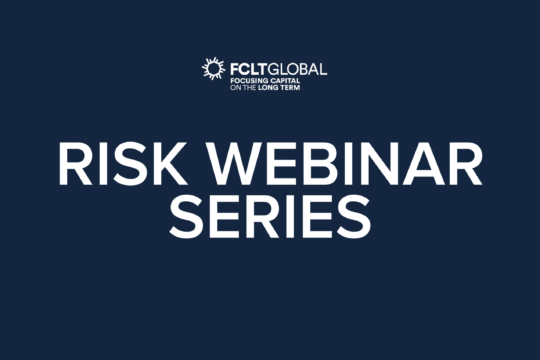Resources
We conduct original research on the causes of short-term business decisions and work to find practical solutions.

Video
21 September 2021 - While many organizations recognize the importance of considering constituencies such as workers, suppliers, customers, society and the environment in business and investment decision-making, implementation of new practices and behaviors has been inconsistent, and their effectiveness has been hard to measure.

Risk and Resilience | Video
21 May 2021 - The world’s infrastructure systems face critical challenges as we look to meet the needs of a growing, increasingly urban population while at the same time dramatically reducing carbon emissions. Technological advances and the Covid-19 epidemic have expanded our conception of critical infrastructure, as telecommunications and other resources become imperative to people and economies around the world.

Risk and Resilience | Video
17 May 2021 - In this final episode of FCLTGlobal’s risk-webinar series, we turn our attention to why long-term institutions manage investment risk in a multi-horizon way: because it positions them for pursuing opportunities purposefully and strategically.

Risk and Resilience | Video
3 May 2021 - Crises happen. Long-term investors are more exposed to them simply by virtue of their long holding periods. Their task cannot be to avoid crises, so instead they have to be resilient to them, which includes being able to anticipate them as well as possible so that board and staff know what they can expect, prepare accordingly, and proceed with their eyes wide open. The most widely-used statistics of investment risk, value-at-risk and probability-of-loss, omit details about what happens within an investment period, including how to know when systemic risk is rising and what might happen to their allocations, and newer statistics are beginning to gain traction to address these concerns.

Risk and Resilience | Video
30 April 2021 - In this final episode of FCLTGlobal’s risk-webinar series, we turn our attention to why long-term institutions manage investment risk in a multi-horizon way: because it positions them for pursuing opportunities purposefully and strategically.

Risk and Resilience | Video
14 April 2021 - A discussion from 14 April 2021 among top business leaders and institutional investors on the opportunities ahead to position the food and agriculture industry for a more sustainable future.

Governance | Video
5 March 2021 - The Denny Center for Democratic Capitalism at Georgetown Law held a virtual conversation with the authors of our recent report, Corporate Long-term Behaviors: How CEOs and Boards Drive Long-term Value

Risk and Resilience | Video
4 March 2021 - Forthcoming research examines societal income distribution in the statistical sense – such as its volatility, skewness, and kurtosis – and relates it to the macro risk distribution faced by investors. This analysis tests the hypothesis that investors’ efforts to reduce volatility reallocates it to individuals in the form of income volatility, and raises the question - Are investors’ risk management practices contributing to inequality?

Risk and Resilience | Video
10 February 2021 - Forthcoming research examines societal income distribution in the statistical sense – such as its volatility, skewness, and kurtosis – and relates it to the macro risk distribution faced by investors. This analysis tests the hypothesis that investors’ efforts to reduce volatility reallocates it to individuals in the form of income volatility, and raises the question - Are investors’ risk management practices contributing to inequality?

Risk and Resilience | Video
14 January 2021 - “Time diversification” is a principle that an investor’s statistical probability of loss decreases as the holding period increases. Long-term investors may overinterpret this statistical principle to indicate that risk in all of its forms is lower. In fact, longer holding periods also expose investors to a greater scale of potential losses and to more experience with turbulence. Our September webinar introduced the way in which these patterns have implications for diversification and asset allocation, and the implications also extend significantly to the way in which long-term investors define and estimate risk.

Risk and Resilience | Video
13 January 2021 - “Time diversification” is a principle that an investor’s statistical probability of loss decreases as the holding period increases. Long-term investors may overinterpret this statistical principle to indicate that risk in all of its forms is lower. In fact, longer holding periods also expose investors to a greater scale of potential losses and to more experience with turbulence. Our September webinar introduced the way in which these patterns have implications for diversification and asset allocation, and the implications also extend significantly to the way in which long-term investors define and estimate risk.